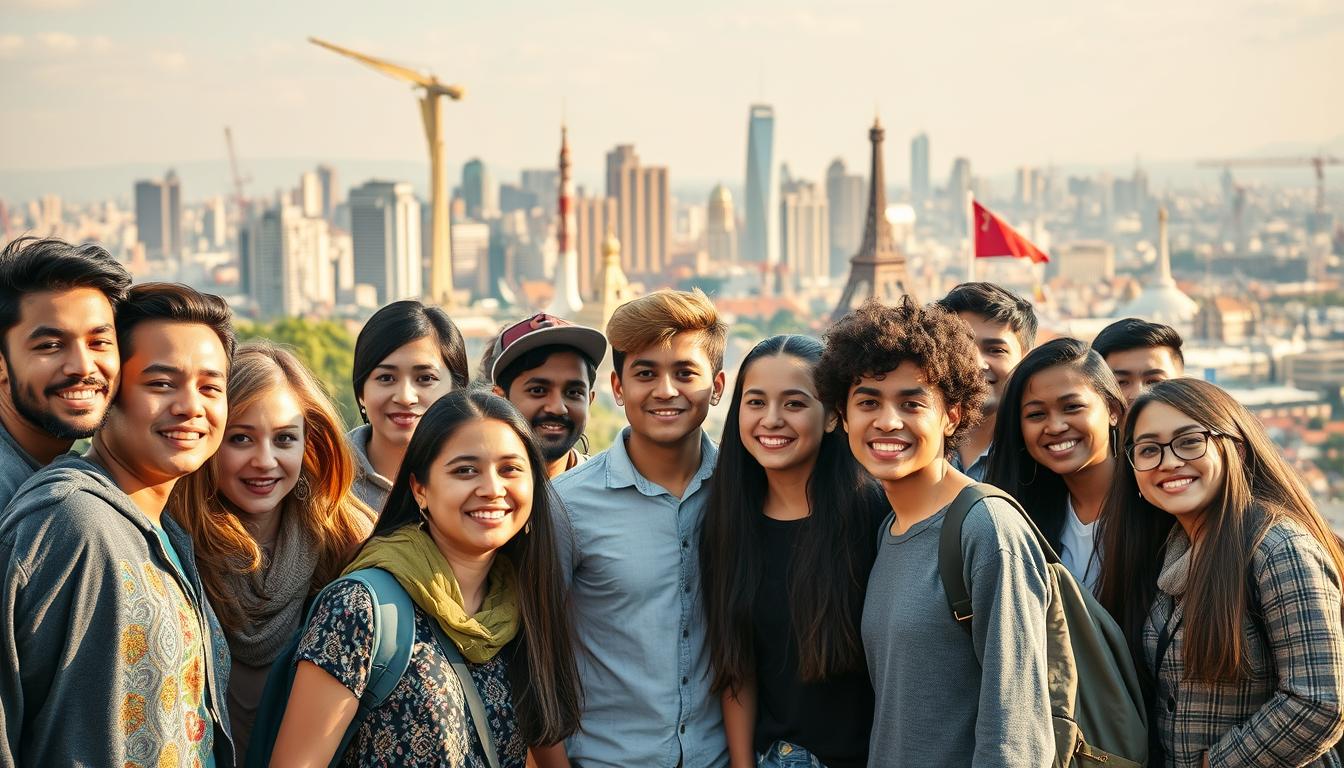Fostering Global Harmony: Impactful Cross-Cultural Understanding Initiatives
In today’s world, understanding different cultures is more important than ever. This understanding helps connect people from all walks of life. It makes us more sensitive to each other’s cultures and helps us communicate better.
By seeing the world from a global perspective, we can learn to appreciate our differences. This way, we can work together towards common goals. Initiatives focused on cross-cultural understanding help us value diversity and make it a part of our lives.
Introduction to Cross-Cultural Understanding
Cross-Cultural Understanding is key in our global world. It’s about valuing cultural differences and diversity. This helps us communicate better across cultures, both personally and professionally.
Definition of Cross-Cultural Understanding
It means knowing and valuing the differences and similarities in cultures. This goes beyond just seeing differences. It’s about truly understanding and appreciating different cultures’ practices and views. This understanding helps us connect with people from other cultures.
Importance of Cross-Cultural Understanding
This understanding is very important today. With more cultural interactions, we need to respect and empathize with each other. Knowing cultural cues helps us build better relationships. It makes us better at dealing with different social situations.
Goals of Cross-Cultural Initiatives
Many initiatives aim to improve cross-cultural understanding. Their main goals are:
- To reduce prejudice and discrimination through education and engagement.
- To increase cultural sensitivity and awareness in different communities.
- To create spaces for dialogue where people can share their experiences and views.
These efforts are vital in helping us understand each other better. They push us toward unity and teamwork.
The Role of Education in Cross-Cultural Understanding
Education is key in teaching people about different cultures. Schools can teach students to live in a world full of diversity. This includes learning about other cultures, the benefits of traveling, and training teachers to teach about diversity.
Cross-Cultural Competency in Schools
Schools are important in teaching students about different cultures. Teachers use books and projects to show students the world’s diversity. Schools also have workshops to teach about cultural awareness.
- Implementing diverse reading lists that highlight various cultural narratives.
- Encouraging group projects that involve collaboration with peers from different backgrounds.
- Hosting workshops and seminars that focus on cultural awareness and sensitivity.
Impact of Study Abroad Programs
Study abroad programs give students real-life experiences with different cultures. These programs help students grow and learn about the world. Students learn new languages, see global issues from different views, and make friends from other places.
- Exposure to new languages, fostering deeper communication skills.
- Hands-on learning about global issues from various cultural perspectives.
- Building lifelong relationships with individuals from diverse backgrounds.
Intercultural Training for Educators
Teachers need training to teach in diverse classrooms. This training helps them meet the needs of all students. It makes learning environments welcoming for everyone.
- Adapt teaching methodologies to better engage students from various backgrounds.
- Implement culturally relevant pedagogy, ensuring all students feel valued.
- Encourage open discussions about cultural differences, promoting respect and understanding.
Community Initiatives That Promote Understanding
Engaging communities in culturally enriching initiatives boosts cross-cultural understanding. These programs help build cultural sensitivity and relationships across different groups. Local cultural exchanges, vibrant festivals, and volunteer programs are great ways to appreciate diversity and strengthen community bonds.
Local Cultural Exchanges
Local cultural exchanges let people dive into different cultures’ customs and traditions. This hands-on experience boosts cultural sensitivity. It helps participants see how people live and connect, building real bonds between diverse groups.
Festivals Celebrating Diversity
Festivals celebrating diversity are key for community engagement. They offer fun and educational experiences about various cultures. Attendees get to try new foods, see art, and learn about traditions, fostering appreciation for diversity.
These events create a space where people can celebrate their differences and find common ground.
Volunteer Programs Bridging Cultures
Volunteer programs are crucial in bridging cultural gaps. People from different backgrounds work together, promoting understanding and teamwork. These experiences help volunteers appreciate diverse views and build strong community ties.
The Business Case for Cross-Cultural Understanding
In today’s global economy, understanding different cultures is key for businesses. Companies that focus on cultural competence see big benefits. They improve how they work and how their teams interact.
Enhancing Global Business Operations
Companies with a global view can better handle diverse markets. They learn to make products that locals want, which boosts customer happiness. This approach also helps them grow their market share.
Businesses that value Cross-Cultural Understanding innovate more and keep customers loyal. They see how important it is for their success.
The Impact on Team Dynamics
Multicultural teams often do better than single-culture ones. They bring different ideas and ways of solving problems. This leads to more creativity and flexibility.
These teams also work better together, thanks to cultural understanding. This makes the workplace more productive and supportive. Companies that welcome diversity see better teamwork and trust.
Successful Multicultural Companies
Many big companies show how Cross-Cultural Understanding helps them succeed. Microsoft and Google are great examples. They focus on diversity and inclusion, which leads to new ideas and products.
These companies attract the best talent from everywhere. They value the unique skills and perspectives of people from different backgrounds. Their commitment to cultural competence makes them leaders in their fields.
Media’s Influence on Cross-Cultural Perceptions
The media greatly shapes how we view different cultures. TV, movies, and newspapers can help us understand or keep stereotypes alive. It’s important to think about how these images affect how we talk to each other across cultures.
Representation in Media and Its Effects
Cultures are shown in many ways in the media. When we see positive images, it helps us appreciate diversity more. But, negative images can make us hold onto wrong ideas. Media does more than entertain; it shapes how we see the world and each other.
Social Media as a Cross-Cultural Tool
Social media is a big deal for connecting cultures. Sites like Instagram and Twitter let us share and connect with people from everywhere. This helps us learn about different cultures and builds bridges between them.
Documentaries Promoting Cultural Awareness
Documentaries are key for learning about different cultures. They share real stories that challenge stereotypes and teach us to value cultural differences. These films inspire us to talk and learn more about the world’s cultures.
Government Policies Supporting Cross-Cultural Understanding
Government policies are key in promoting cross-cultural understanding. They help build cultural competence and a global perspective. These policies create a space where different cultures can live together in peace.
Immigration Policies and Cultural Integration
Immigration policies shape how cultures blend into society. By supporting cultural competence, governments aid immigrants in adapting while keeping their cultural roots. This benefits both the newcomers and the community they join.
International Collaboration and Diplomacy
Working together globally is vital for solving cultural conflicts and understanding. Diplomatic efforts focused on cultural exchange boost appreciation for diversity. This leads to better global cooperation and understanding.
Funding for Cultural Exchange Programs
Supporting cultural exchange programs is essential for bridging cultural gaps. These programs let people share their traditions and values. They improve cultural understanding and build global connections.
The Impact of Technology on Cross-Cultural Communication
Technology has changed how we talk to people from other cultures. It lets us connect from far away. Now, thanks to digital tools, understanding different cultures is easier.
Virtual reality, language apps, and social networks help us be more sensitive to cultures. They also help us see the world from different viewpoints.
Virtual Reality in Cultural Experiences
Virtual reality (VR) takes us into different cultures. It lets us see and feel other places and traditions from home. This way, we learn to appreciate the diversity of cultures.
By experiencing cultures in VR, we grow more empathetic. We understand the world in a deeper way. This helps us communicate better across cultures.
Language Translation Apps
Language apps have made talking to people from other countries easier. They help break down language barriers. Now, we can have real conversations without language getting in the way.
These apps are getting better at translating fast and accurately. They help us share ideas and show respect for other cultures. This makes communication more open and understanding.
Social Networking and Global Connections
Social networks connect us to people worldwide. We can share our experiences and learn from others. This creates a rich global conversation.
These platforms help us make friends and work together, no matter where we are. They build a sense of community that knows no borders.
Case Studies of Successful Cross-Cultural Programs
Many cross-cultural programs have made a big difference worldwide. They have helped people understand and respect different cultures. These efforts show how working together can break down barriers and bring people closer.
The United Nations and Global Initiatives
The United Nations is key in promoting cultural understanding. It runs programs like UNESCO to improve cross-cultural training. These programs aim to teach people to value and respect cultural differences globally.
Nonprofit Organizations Making a Difference
Nonprofit groups are working hard to bridge cultural gaps. Organizations like the International Institute for Peace focus on dialogue between cultures. They help reduce prejudice and build cultural competence by bringing people together.
Corporate Diversity Programs
Companies are also playing a big role in promoting diversity. Google is a great example, with its strong focus on cultural competence training. These programs help create inclusive workplaces, leading to better teamwork and innovation.
Challenges in Achieving Cross-Cultural Understanding
Even with progress in cultural competence and intercultural communication, big challenges still exist. These hurdles can make diversity appreciation efforts less effective. It’s important to know about these obstacles for those working on cross-cultural interactions.
Language Barriers
Language misunderstandings often block effective communication. When people can’t share their thoughts in a common language, it leads to confusion and frustration. This makes building strong relationships between different cultures hard. To overcome this, we need to learn new languages and be open to different ways of speaking.
Prejudice and Stereotypes
Prejudices and stereotypes can stop real cross-cultural connections. These biases cloud our judgment and create distrust. To overcome this, we must face these biases head-on. Programs that teach about different cultures are key to breaking down harmful stereotypes.
Global Conflicts Impacting Relations
Global conflicts add to cultural tensions and hurt intercultural communication. News from one part of the world can make people see other cultures in a bad light. To fight this, we need to support efforts that promote dialogue and understanding between conflicting groups.
Future Directions for Cross-Cultural Understanding
The future of understanding between cultures looks bright. It focuses on a global view. This is key for talking and working well with people from different cultures.
Emphasis on Global Citizenship
Being a global citizen means seeing ourselves as part of a bigger world. It helps us understand and respect different cultures. This way, we can learn from each other and grow together.
Role of Youth in Cultural Exchange
Young people are crucial in building bridges between cultures. They take part in cultural exchanges, creating lasting connections. Through these experiences, they become champions of understanding and respect.
Innovations in Collaborative Platforms
New technologies and platforms are changing how we connect across cultures. They let us share and learn from each other, no matter where we are. These tools help us build empathy and understanding.
Conclusion: A Call to Action for Cross-Cultural Engagement
In today’s world, it’s more important than ever to work on understanding different cultures. Efforts to improve how we talk across cultures help break down walls between people. It’s key to be open to learning from others, which helps us build strong connections.
Every person can help make the world a more harmonious place. Small actions like being kind and listening can make a big difference. By doing these things, we help create a world where everyone’s culture is valued.
The dream of a united future depends on respect and understanding between cultures. By working together and talking openly, we can build bridges between different communities. As our world gets smaller, it’s crucial we all work towards peace and understanding.
FAQ
What is cross-cultural understanding?
Why is cross-cultural understanding important?
What are the goals of cross-cultural initiatives?
How does education contribute to cross-cultural understanding?
What types of community initiatives promote cross-cultural understanding?
How does cross-cultural understanding impact businesses?
In what ways does the media influence cross-cultural perceptions?
What role do government policies play in cross-cultural understanding?
How has technology impacted cross-cultural communication?
Can you provide examples of successful cross-cultural programs?
What challenges exist in achieving cross-cultural understanding?
What are the future directions for cross-cultural understanding?
Published on: 28 de March de 2025

Luke Martin
Luke Martin, author of Credwallets.com, is a mathematics graduate with a specialization in financial markets. Known for his love of pets and his passion for sharing knowledge, Luke created the site to provide valuable insights into the complexities of the financial world. His approachable style and dedication to helping others make informed financial decisions make his work accessible to all, whether they're new to finance or seasoned investors.







